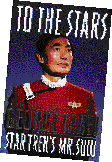ASIAN CALIFORNIA
Page 9 of 12
Notable in particular is the way the patrols brought Japanese Americans and recent Japanese immigrants together, overcoming barriers of language, culture and age that previously kept the community divided. The patrols also served to bridge Little Tokyo with the nearby Chinatown district--merchants from Hill and Broadway heard about GLTACA's successes and asked the organization to provide them with training so that Chinatown businesses could start volunteer street patrols of their own.
| "I was probably the only actor on the studio lot who, between camera setups, was reading his world theater history textbook instead of the Daily Variety |
"I see the kids of the new generation of merchants going up and down the street now," Kito beams. "They're going to grow up with the same feelings of community pride that I had."
While the primary Japanese American industry is agriculture--most farms in Oxnard and Imperial Valley are owned by Japanese Americans--Japan Inc. creates some 250,000 jobs in other industries, like automotive and entertainment. Sony and Matsushita will help spur the rise of more California Asians to upper echelon management positions at TV and motion picture studios. They will be joined, says veteran actor George Takei, by burgeoning ranks of Asian American directors and writers.
"When I started my acting career in 1958, we were non-existent in those areas," Takei says. "Now we have executives like Scott Sassa who is president of Turner Entertainment, and Christopher Lee who is executive vice president over at TriStar. We've also got Tony award-winning playwright David Henry Wong, who did M. Butterfly, and the movie, Golden Gate. And then there's Phillip Kan Gotan, and screenwriters like Desmond Nakano. What's very positive about the contributions of these writers and directors is that they are not limiting themselves to projects focused on Asian American interests and issues. They're exploring black-white race relations and the experiences of Mexican Americans in East L.A."
Takei's family was interned at Tule Lake during WWII. After the war, he studied architecture at UC Berkeley until his passion for theater took hold. He left Berkeley for UCLA where his career took off.
"I was probably the only actor on the studio lot who, between camera setups, was reading his world theater history textbook instead of the Daily Variety," says Takei in his autobiography To The Stars. His early works included Warner Brothers' Ice Palace, the TV series Hawaiian Eye and Hell To Eternity, the first Hollywood film to deal with the internment of Japanese Americans. But he is, of course, most well known to world television audiences as Star Trek's Mr. Sulu.
Takei still keeps his ear to the Hollywood beat and is particularly supportive of Asian American Arts. He notes, however, that California's Asian audiences are somewhat wanting in the ticket-buying department.
"I don't think we as Asian Americans have gotten to the point yet where we count at the box office," he says. "The reason is that we don't make ourselves felt," says the former Starfleet crew member. Certainly, we're at the position economically where we should make ourselves felt. But the fact is, we don't."
Go to a theatrical or motion picture production by almost any popular black director, writer or star, and notice the huge turnout of blacks in the audience, says Takei. Then go to a stage show or film by Asian American artists and notice the sparse attendance by Asian Americans.

George Takei's autobiography called as much attention to his childhood at Tule Lake internment camp, as to his years as Star Trek's Mr. Sulu.
"Asian Americans don't support their own theatrical and motion picture creators and artists by buying tickets and attending the shows in the same way that other minorities do, African Americans in particular."
Perhaps it's their upbringing.
"The Asian American experience has not been one, historically, of supporting our own artists and creative talent," he says. "If anything, the earlier generations have had a legacy of dissuading their young from entering the arts and entertainment fields. That's not the way you keep a low profile, getting up on stage or in front of a camera, they would tell us. In addition, going to see a play or even a movie tends to be for first- and even second-generation Asian Americans something of a luxury because so many of them lead that hardscrabble existence when they first arrive in the U.S. I think with fourth- and fifth-generation Asian Americans this tendency to not be supportive of the arts and entertainment is something that is on the decline. Financial successes are more broadly dispersed in these groups, therefore, more of them can afford to be supportive at the box office."
But the Japanese American cultural picture is changing and as it does, so will the picture of the audience. Page 10
| Page 1 |
2 |
3 |
4 |
5 |
6 |
7 |
8 |
9 |
10 |
11 |
12 |
CONTACT US
|
ADVERTISING INFO
© 1996-2013 Asian Media Group Inc
No part of the contents of this site may be reproduced without prior written permission.
